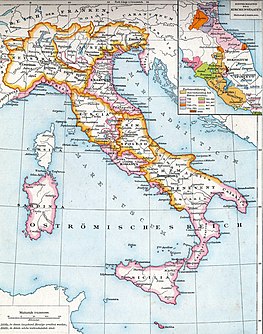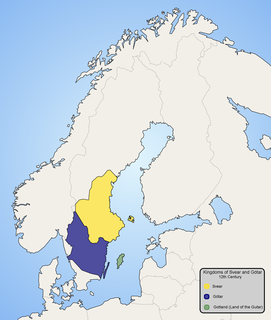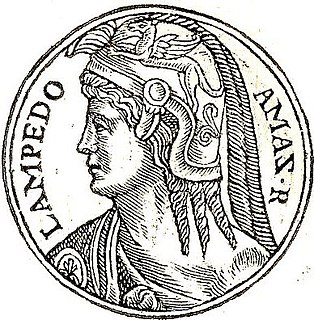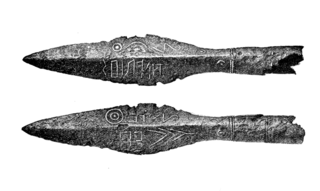
In Greek mythology, the Amazons are portrayed in a number of ancient epic poems and legends, such as the Labours of Hercules, the Argonautica and the Iliad. They were a group of female warriors and hunters, who matched men in physical agility and strength, in archery, riding skills and the arts of combat. Their society was closed for men and they only raised their daughters, either killing their sons or returning them to their fathers, with whom they would only socialize briefly in order to reproduce.
The Cimbri were an ancient tribe in Europe. Ancient authors described them variously as a Celtic people, Germanic people, or even Cimmerian. Several ancient sources indicate that they lived in Jutland, which in some classical texts was called the Cimbrian peninsula. There is no direct evidence for the language they spoke, though some scholars argue that it must have been a Germanic language, while others argue that it must have been Celtic.

The Germanic peoples were a historical group of people living in Central Europe and Scandinavia. Since the 19th century, they have traditionally been defined by the use of ancient and early medieval Germanic languages and are thus equated at least approximately with Germanic-speaking peoples, although different academic disciplines have their own definitions of what makes someone or something "Germanic". The Romans named the area in which Germanic peoples lived Germania, stretching West to East between the Vistula and Rhine rivers and north to south from Southern Scandinavia to the upper Danube. In discussions of the Roman period, the Germanic peoples are sometimes referred to as Germani or ancient Germans, although many scholars consider the second term problematic, since it suggests identity with modern Germans. The very concept of "Germanic peoples" has become the subject of controversy among modern scholars, with some calling for its total abandonment.

The Huns were a nomadic people who lived in Central Asia, the Caucasus, and Eastern Europe between the 4th and 6th century AD. According to European tradition, they were first reported living east of the Volga River, in an area that was part of Scythia at the time; the Huns' arrival is associated with the migration westward of an Iranian people, the Alans. By 370 AD, the Huns had arrived on the Volga, and by 430 the Huns had established a vast, if short-lived, dominion in Europe, conquering the Goths and many other Germanic peoples living outside of Roman borders, and causing many others to flee into Roman territory. The Huns, especially under their King Attila, made frequent and devastating raids into the Eastern Roman Empire. In 451, the Huns invaded the Western Roman province of Gaul, where they fought a combined army of Romans and Visigoths at the Battle of the Catalaunian Fields, and in 452 they invaded Italy. After Attila's death in 453, the Huns ceased to be a major threat to Rome and lost much of their empire following the Battle of Nedao (454?). Descendants of the Huns, or successors with similar names, are recorded by neighbouring populations to the south, east, and west as having occupied parts of Eastern Europe and Central Asia from about the 4th to 6th centuries. Variants of the Hun name are recorded in the Caucasus until the early 8th century.

The Lombards or Langobards were a Germanic people who ruled most of the Italian Peninsula from 568 to 774, with origins near the Elbe in northern Germany and Scania in southern Sweden before the Migration Period.

The Heruli were an early Germanic people. Possibly originating in Scandinavia, the Heruli are first mentioned by Roman authors as one of several "Scythian" groups raiding Roman provinces in the Balkans and the Aegean Sea, attacking by land, and notably also by sea. During this time they reportedly lived near the Sea of Azov.

The Thuringii, Toringi or Teuriochaimai, were an early Germanic people that appeared during the late Migration Period in the Harz Mountains of central Germania, a region still known today as Thuringia. It became a kingdom, which came into conflict with the Merovingian Franks, and it later came under their influence and Frankish control. The name is still used for one of modern Germany's federal states (Bundesländer).
Germans are the natives or inhabitants of Germany, and sometimes more broadly any people who are of German descent or native speakers of the German language. The constitution of Germany defines a German as a German citizen. During the 19th and much of the 20th century, discussions on German identity were dominated by concepts of a common language, culture, descent and history. Today, the German language is widely seen as the primary though not exclusive criterion of German identity. Estimates on the total number of Germans in the world range from 100 to 150 million, and most of them live in Germany.

The Swedes (probably from the PIE reflexive pronominal root *s e, "one's own [tribesmen/kinsmen]"; Old English: Swēon) were a North Germanic tribe who inhabited Svealand in central Sweden and one of the progenitor groups of modern Swedes, along with Geats and Gutes. They had their tribal centre in Gamla Uppsala.

Themyscira is a fictional unitary sovereign city-state and archipelagic island nation appearing in American comic books published by DC Comics. Previously known as Paradise Island and the Amazon Isles, it first appeared in All Star Comics #8.

Hunor and Magor were, according to Hungarian legend, the ancestors of the Huns and the Magyars. The legend was first promoted in Gesta Hunnorum et Hungarorum. The legend's aim in providing a common ancestry for the Huns and the Magyars was to suggest historical continuum of the Kingdom of Hungary with the Hun Empire. Magyars led by prince Árpád had conquered the area in the 890s. The territory had previously been held by Attila the Hun in the 5th century. The legend thus tried to prove that the Magyars were simply reclaiming their ancient homeland as descendants of Attila. According to Simon of Kéza, Hunor and Magor were the sons of Ménrót, a mythical giant, who he partly identified with Nimrod of the Bible.
The Amazons of DC Comics are a race of warrior women who exist as part of Greek mythology. They live on Paradise Island, later known as Themyscira, an isolated location in the middle of the ocean where they are hidden from Man's World.

Lampedo is an Amazon queen mentioned in Roman historiography. She ruled with her sister Marpesia. The sisters called themselves daughters of Mars to put terror in the heart of their enemies to show they were incredible warriors to be feared. Her name was speculated to refer to traditional New Moon torchlit processions in honor of Artemis, goddess of the hunt.

The Tulingi were a small tribe closely allied to the Celtic Helvetii in the time of Julius Caesar's conquest of Gaul. Their location is unknown; their language and descent are uncertain. From their close cooperation with the Helvetii it can be deduced that they were probably neighbours of the latter. At the Battle of Bibracte in 58 BCE, they were, with the Boii and a few other smaller tribes, allies of the Helvetii against the Roman legions of Caesar.
Valasca is a woman mentioned in the History of Bohemia by Aeneas Silvius. She was also called Vlasta and was supporter of the mythical Bohemian Princess Libuše.
The Germani cisrhenani, or "Left bank Germani", were a group of Germanic peoples who lived west of the Lower Rhine at the time of the Gallic Wars in the mid-1st century BC.

North Germanic peoples, commonly called Scandinavians, Nordic peoples and in a medieval context Norsemen, are a Germanic ethnolinguistic group of the Nordic countries. They are identified by their cultural similarities, common ancestry and common use of the Proto-Norse language from around 200 AD, a language that around 800 AD became the Old Norse language, which in turn later became the North Germanic languages of today.

Gothic religion was the original religion of the Goths before their conversion to Christianity.

Early Germanic culture refers to the culture of the early Germanic peoples. Largely derived from a synthesis of Proto-Indo-European and indigenous Northern European elements, the Germanic culture developed out of the Nordic Bronze Age. It came under significant external influence during the Migration Period, particularly from ancient Rome.












